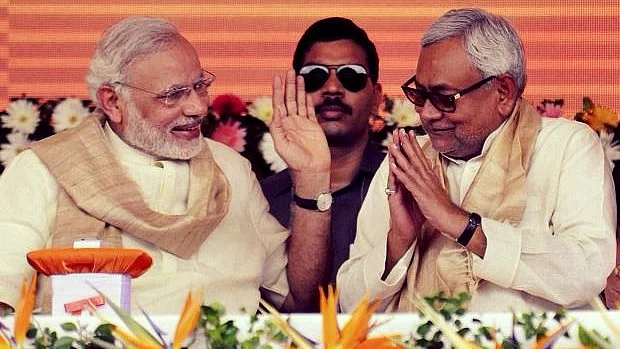Nitish Kumar's shocking resignation, and subsequent reinstatement as the Chief Minister of Bihar has set of a political storm in the state. The discussion has now shifted from the imminent breakdown of the mahagathbandhan to what the implications of a BJP-JDU coalition in the state would be.
On the morning of 27 July, as Kumar was sworn in as the CM again, this time with BJP support, the ripples are bound to be felt from the state all the way to the centre.
Kumar has been asked to prove his majority in the Assembly on 29 July. He appears to have the numbers – with the JD(U)'s 71 MLAs, and 58 MLAs of the BJP and its allies.
What Does Nitish’s Return Mean for NDA?
The BJP's dreams of acquiring power in the state were shattered in 2015, after Bihar voted for the Grand Alliance in the assembly elections. But by putting a dent in the now erstwhile JDU-RJD-Congress grand alliance, not only does the BJP gain strong footing in the state, but also stands to strengthen the NDA in the Rajya Sabha.
Also Read: With Modi, Shah Calling Shots, Nitish's Ghar Wapsi to Face Hurdles
While the NDA has a majority government in the centre, it is still not strong enough in the Upper House. But JD(U)'s 'wapsi' means the NDA now has 10 more members in the Rajya Sabha, taking its numbers to 84.
Besides, with BJP leader Sushil Kumar Modi sworn in as the Deputy CM and the party sharing partnership in the Nitish government, JD(U) leaders may get posts in the central government too.
(This article was first published on Quint Hindi. It has been translated by Suhasini Krishnan)
(We all love to express ourselves, but how often do we do it in our mother tongue? Here's your chance! This Independence Day, khul ke bol with BOL – Love your Bhasha. Sing, write, perform, spew poetry – whatever you like – in your mother tongue. Send us your BOL at bol@thequint.com or WhatsApp it to 9910181818.)
(At The Quint, we question everything. Play an active role in shaping our journalism by becoming a member today.)
